A Comprehensive Comparison: Healthcare Systems in USA and Canada
VerifiedAdded on 2023/06/13
|8
|1891
|66
Essay
AI Summary
This essay provides a detailed comparison of the healthcare systems in the United States and Canada, focusing on funding models, organizational structures, and performance metrics. It highlights the differences in government involvement, payment mechanisms, and service delivery between the two countries. The US healthcare system, characterized by a multi-payer approach and higher spending, is contrasted with Canada's single-payer, universal healthcare system. The analysis also touches on cost-effectiveness, potential reforms, and the importance of addressing core building blocks to improve healthcare delivery in both nations. The essay concludes that while the US spends more on healthcare, Canada achieves broader coverage and better health outcomes, suggesting areas for potential learning and reform in both systems. Access similar documents and study tools on Desklib.
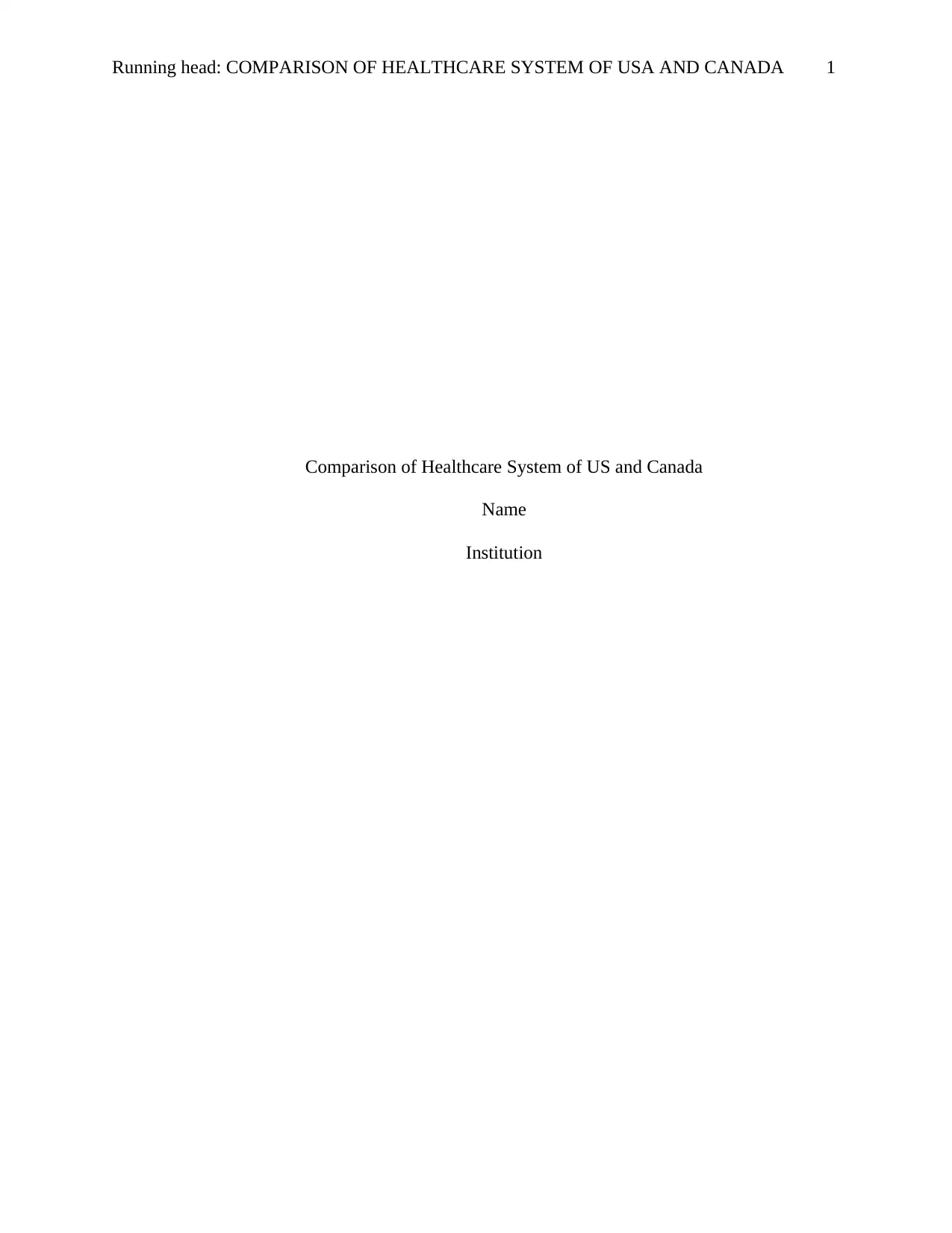
Running head: COMPARISON OF HEALTHCARE SYSTEM OF USA AND CANADA 1
Comparison of Healthcare System of US and Canada
Name
Institution
Comparison of Healthcare System of US and Canada
Name
Institution
Paraphrase This Document
Need a fresh take? Get an instant paraphrase of this document with our AI Paraphraser
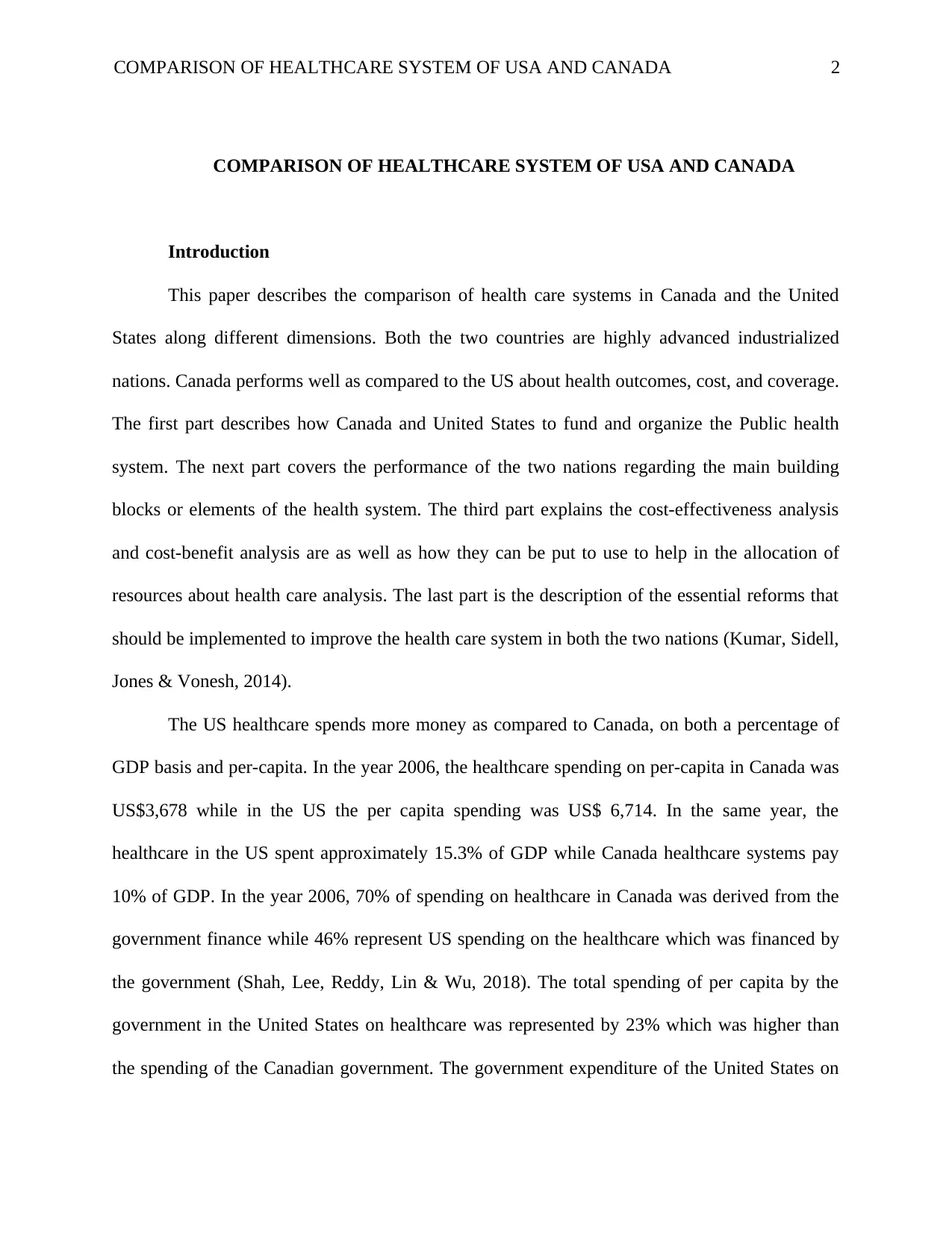
COMPARISON OF HEALTHCARE SYSTEM OF USA AND CANADA 2
COMPARISON OF HEALTHCARE SYSTEM OF USA AND CANADA
Introduction
This paper describes the comparison of health care systems in Canada and the United
States along different dimensions. Both the two countries are highly advanced industrialized
nations. Canada performs well as compared to the US about health outcomes, cost, and coverage.
The first part describes how Canada and United States to fund and organize the Public health
system. The next part covers the performance of the two nations regarding the main building
blocks or elements of the health system. The third part explains the cost-effectiveness analysis
and cost-benefit analysis are as well as how they can be put to use to help in the allocation of
resources about health care analysis. The last part is the description of the essential reforms that
should be implemented to improve the health care system in both the two nations (Kumar, Sidell,
Jones & Vonesh, 2014).
The US healthcare spends more money as compared to Canada, on both a percentage of
GDP basis and per-capita. In the year 2006, the healthcare spending on per-capita in Canada was
US$3,678 while in the US the per capita spending was US$ 6,714. In the same year, the
healthcare in the US spent approximately 15.3% of GDP while Canada healthcare systems pay
10% of GDP. In the year 2006, 70% of spending on healthcare in Canada was derived from the
government finance while 46% represent US spending on the healthcare which was financed by
the government (Shah, Lee, Reddy, Lin & Wu, 2018). The total spending of per capita by the
government in the United States on healthcare was represented by 23% which was higher than
the spending of the Canadian government. The government expenditure of the United States on
COMPARISON OF HEALTHCARE SYSTEM OF USA AND CANADA
Introduction
This paper describes the comparison of health care systems in Canada and the United
States along different dimensions. Both the two countries are highly advanced industrialized
nations. Canada performs well as compared to the US about health outcomes, cost, and coverage.
The first part describes how Canada and United States to fund and organize the Public health
system. The next part covers the performance of the two nations regarding the main building
blocks or elements of the health system. The third part explains the cost-effectiveness analysis
and cost-benefit analysis are as well as how they can be put to use to help in the allocation of
resources about health care analysis. The last part is the description of the essential reforms that
should be implemented to improve the health care system in both the two nations (Kumar, Sidell,
Jones & Vonesh, 2014).
The US healthcare spends more money as compared to Canada, on both a percentage of
GDP basis and per-capita. In the year 2006, the healthcare spending on per-capita in Canada was
US$3,678 while in the US the per capita spending was US$ 6,714. In the same year, the
healthcare in the US spent approximately 15.3% of GDP while Canada healthcare systems pay
10% of GDP. In the year 2006, 70% of spending on healthcare in Canada was derived from the
government finance while 46% represent US spending on the healthcare which was financed by
the government (Shah, Lee, Reddy, Lin & Wu, 2018). The total spending of per capita by the
government in the United States on healthcare was represented by 23% which was higher than
the spending of the Canadian government. The government expenditure of the United States on
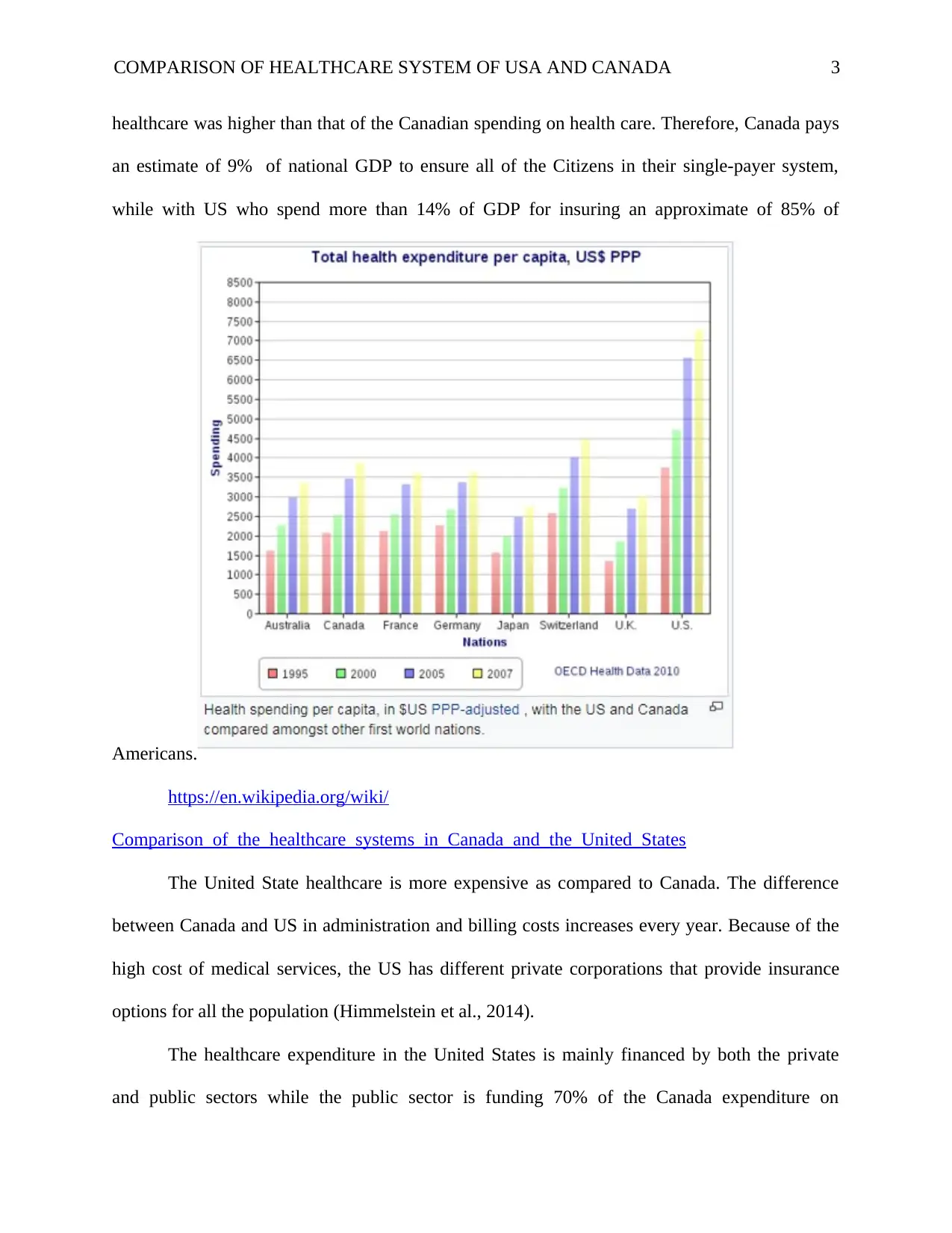
COMPARISON OF HEALTHCARE SYSTEM OF USA AND CANADA 3
healthcare was higher than that of the Canadian spending on health care. Therefore, Canada pays
an estimate of 9% of national GDP to ensure all of the Citizens in their single-payer system,
while with US who spend more than 14% of GDP for insuring an approximate of 85% of
Americans.
https://en.wikipedia.org/wiki/
Comparison_of_the_healthcare_systems_in_Canada_and_the_United_States
The United State healthcare is more expensive as compared to Canada. The difference
between Canada and US in administration and billing costs increases every year. Because of the
high cost of medical services, the US has different private corporations that provide insurance
options for all the population (Himmelstein et al., 2014).
The healthcare expenditure in the United States is mainly financed by both the private
and public sectors while the public sector is funding 70% of the Canada expenditure on
healthcare was higher than that of the Canadian spending on health care. Therefore, Canada pays
an estimate of 9% of national GDP to ensure all of the Citizens in their single-payer system,
while with US who spend more than 14% of GDP for insuring an approximate of 85% of
Americans.
https://en.wikipedia.org/wiki/
Comparison_of_the_healthcare_systems_in_Canada_and_the_United_States
The United State healthcare is more expensive as compared to Canada. The difference
between Canada and US in administration and billing costs increases every year. Because of the
high cost of medical services, the US has different private corporations that provide insurance
options for all the population (Himmelstein et al., 2014).
The healthcare expenditure in the United States is mainly financed by both the private
and public sectors while the public sector is funding 70% of the Canada expenditure on
⊘ This is a preview!⊘
Do you want full access?
Subscribe today to unlock all pages.

Trusted by 1+ million students worldwide
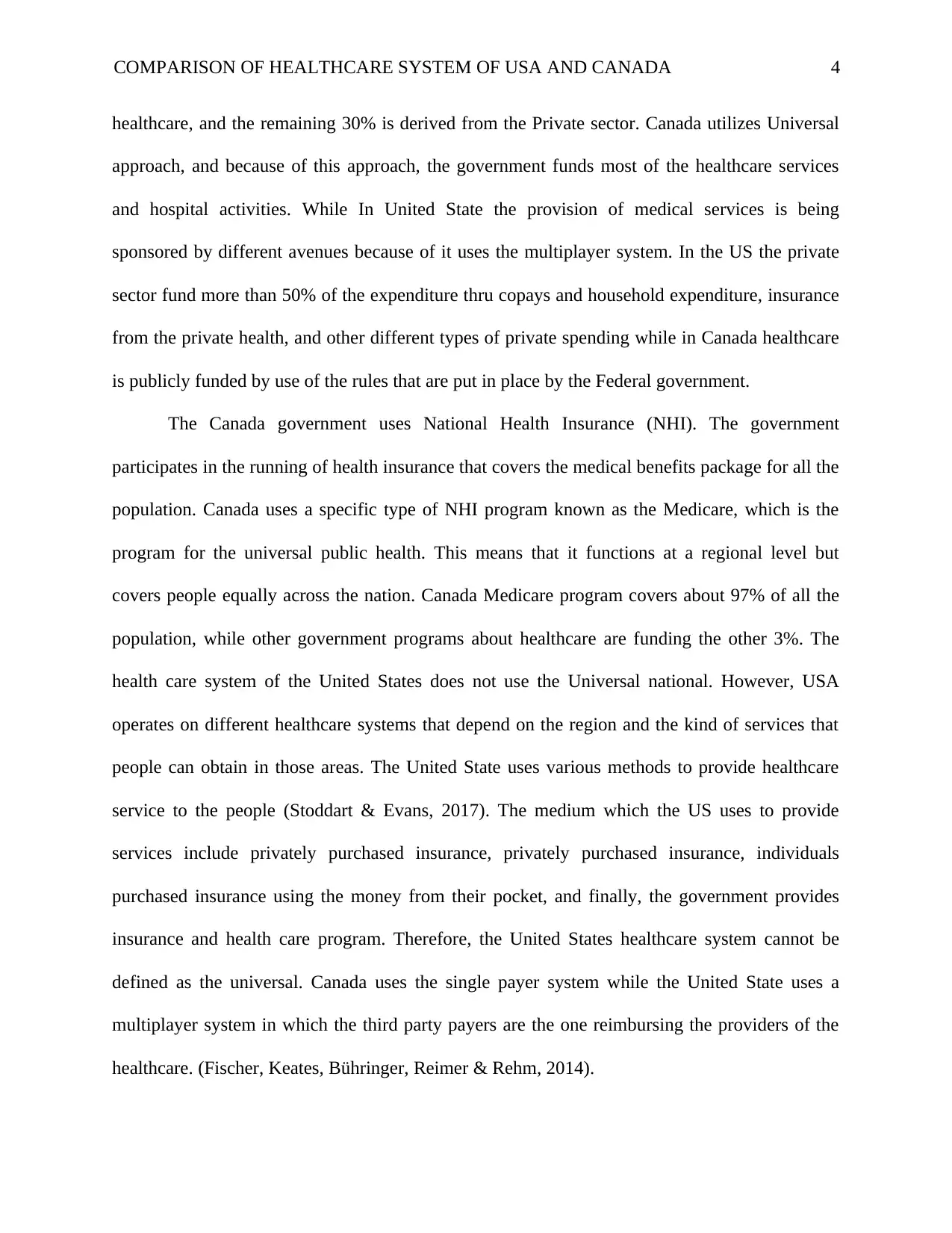
COMPARISON OF HEALTHCARE SYSTEM OF USA AND CANADA 4
healthcare, and the remaining 30% is derived from the Private sector. Canada utilizes Universal
approach, and because of this approach, the government funds most of the healthcare services
and hospital activities. While In United State the provision of medical services is being
sponsored by different avenues because of it uses the multiplayer system. In the US the private
sector fund more than 50% of the expenditure thru copays and household expenditure, insurance
from the private health, and other different types of private spending while in Canada healthcare
is publicly funded by use of the rules that are put in place by the Federal government.
The Canada government uses National Health Insurance (NHI). The government
participates in the running of health insurance that covers the medical benefits package for all the
population. Canada uses a specific type of NHI program known as the Medicare, which is the
program for the universal public health. This means that it functions at a regional level but
covers people equally across the nation. Canada Medicare program covers about 97% of all the
population, while other government programs about healthcare are funding the other 3%. The
health care system of the United States does not use the Universal national. However, USA
operates on different healthcare systems that depend on the region and the kind of services that
people can obtain in those areas. The United State uses various methods to provide healthcare
service to the people (Stoddart & Evans, 2017). The medium which the US uses to provide
services include privately purchased insurance, privately purchased insurance, individuals
purchased insurance using the money from their pocket, and finally, the government provides
insurance and health care program. Therefore, the United States healthcare system cannot be
defined as the universal. Canada uses the single payer system while the United State uses a
multiplayer system in which the third party payers are the one reimbursing the providers of the
healthcare. (Fischer, Keates, Bühringer, Reimer & Rehm, 2014).
healthcare, and the remaining 30% is derived from the Private sector. Canada utilizes Universal
approach, and because of this approach, the government funds most of the healthcare services
and hospital activities. While In United State the provision of medical services is being
sponsored by different avenues because of it uses the multiplayer system. In the US the private
sector fund more than 50% of the expenditure thru copays and household expenditure, insurance
from the private health, and other different types of private spending while in Canada healthcare
is publicly funded by use of the rules that are put in place by the Federal government.
The Canada government uses National Health Insurance (NHI). The government
participates in the running of health insurance that covers the medical benefits package for all the
population. Canada uses a specific type of NHI program known as the Medicare, which is the
program for the universal public health. This means that it functions at a regional level but
covers people equally across the nation. Canada Medicare program covers about 97% of all the
population, while other government programs about healthcare are funding the other 3%. The
health care system of the United States does not use the Universal national. However, USA
operates on different healthcare systems that depend on the region and the kind of services that
people can obtain in those areas. The United State uses various methods to provide healthcare
service to the people (Stoddart & Evans, 2017). The medium which the US uses to provide
services include privately purchased insurance, privately purchased insurance, individuals
purchased insurance using the money from their pocket, and finally, the government provides
insurance and health care program. Therefore, the United States healthcare system cannot be
defined as the universal. Canada uses the single payer system while the United State uses a
multiplayer system in which the third party payers are the one reimbursing the providers of the
healthcare. (Fischer, Keates, Bühringer, Reimer & Rehm, 2014).
Paraphrase This Document
Need a fresh take? Get an instant paraphrase of this document with our AI Paraphraser
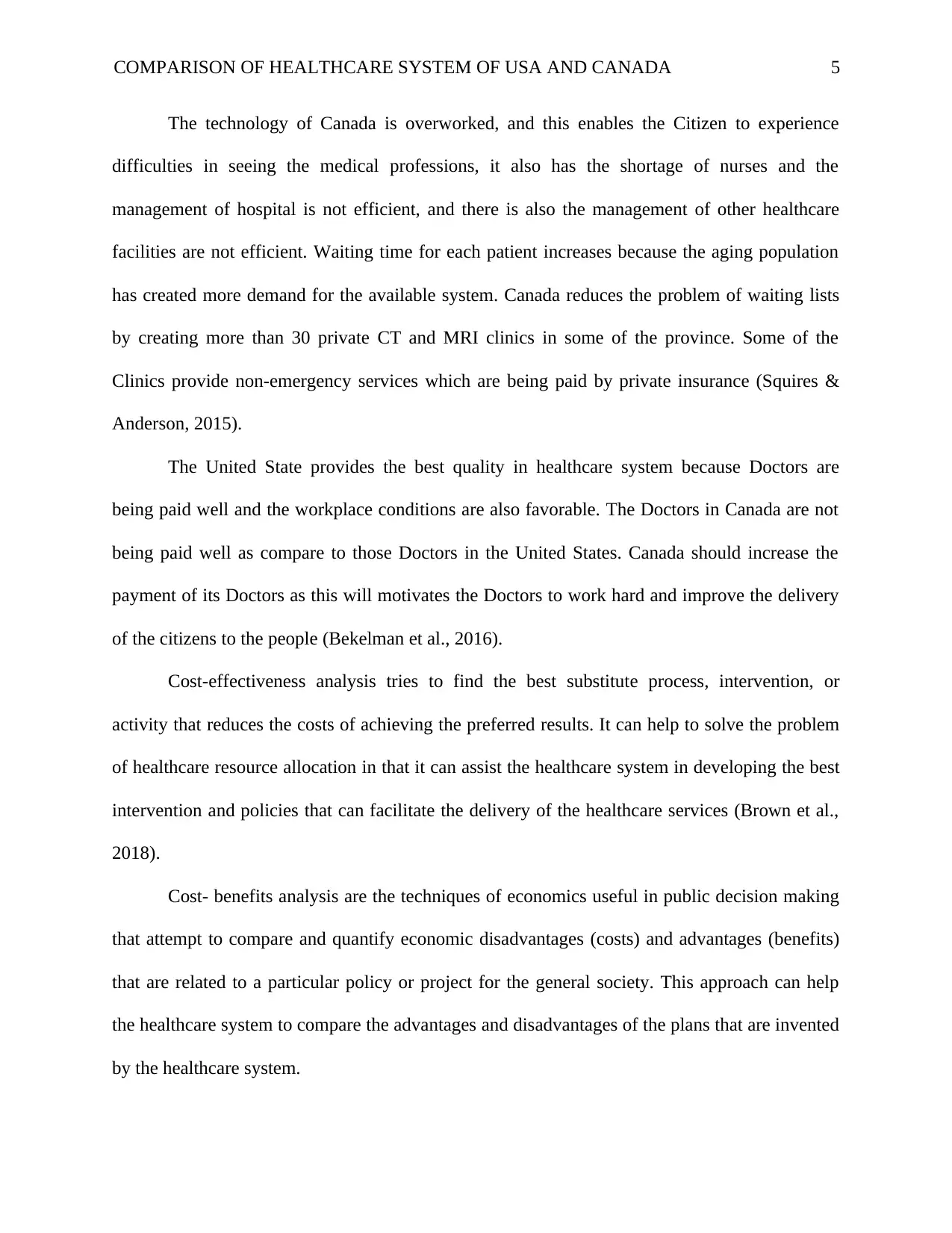
COMPARISON OF HEALTHCARE SYSTEM OF USA AND CANADA 5
The technology of Canada is overworked, and this enables the Citizen to experience
difficulties in seeing the medical professions, it also has the shortage of nurses and the
management of hospital is not efficient, and there is also the management of other healthcare
facilities are not efficient. Waiting time for each patient increases because the aging population
has created more demand for the available system. Canada reduces the problem of waiting lists
by creating more than 30 private CT and MRI clinics in some of the province. Some of the
Clinics provide non-emergency services which are being paid by private insurance (Squires &
Anderson, 2015).
The United State provides the best quality in healthcare system because Doctors are
being paid well and the workplace conditions are also favorable. The Doctors in Canada are not
being paid well as compare to those Doctors in the United States. Canada should increase the
payment of its Doctors as this will motivates the Doctors to work hard and improve the delivery
of the citizens to the people (Bekelman et al., 2016).
Cost-effectiveness analysis tries to find the best substitute process, intervention, or
activity that reduces the costs of achieving the preferred results. It can help to solve the problem
of healthcare resource allocation in that it can assist the healthcare system in developing the best
intervention and policies that can facilitate the delivery of the healthcare services (Brown et al.,
2018).
Cost- benefits analysis are the techniques of economics useful in public decision making
that attempt to compare and quantify economic disadvantages (costs) and advantages (benefits)
that are related to a particular policy or project for the general society. This approach can help
the healthcare system to compare the advantages and disadvantages of the plans that are invented
by the healthcare system.
The technology of Canada is overworked, and this enables the Citizen to experience
difficulties in seeing the medical professions, it also has the shortage of nurses and the
management of hospital is not efficient, and there is also the management of other healthcare
facilities are not efficient. Waiting time for each patient increases because the aging population
has created more demand for the available system. Canada reduces the problem of waiting lists
by creating more than 30 private CT and MRI clinics in some of the province. Some of the
Clinics provide non-emergency services which are being paid by private insurance (Squires &
Anderson, 2015).
The United State provides the best quality in healthcare system because Doctors are
being paid well and the workplace conditions are also favorable. The Doctors in Canada are not
being paid well as compare to those Doctors in the United States. Canada should increase the
payment of its Doctors as this will motivates the Doctors to work hard and improve the delivery
of the citizens to the people (Bekelman et al., 2016).
Cost-effectiveness analysis tries to find the best substitute process, intervention, or
activity that reduces the costs of achieving the preferred results. It can help to solve the problem
of healthcare resource allocation in that it can assist the healthcare system in developing the best
intervention and policies that can facilitate the delivery of the healthcare services (Brown et al.,
2018).
Cost- benefits analysis are the techniques of economics useful in public decision making
that attempt to compare and quantify economic disadvantages (costs) and advantages (benefits)
that are related to a particular policy or project for the general society. This approach can help
the healthcare system to compare the advantages and disadvantages of the plans that are invented
by the healthcare system.
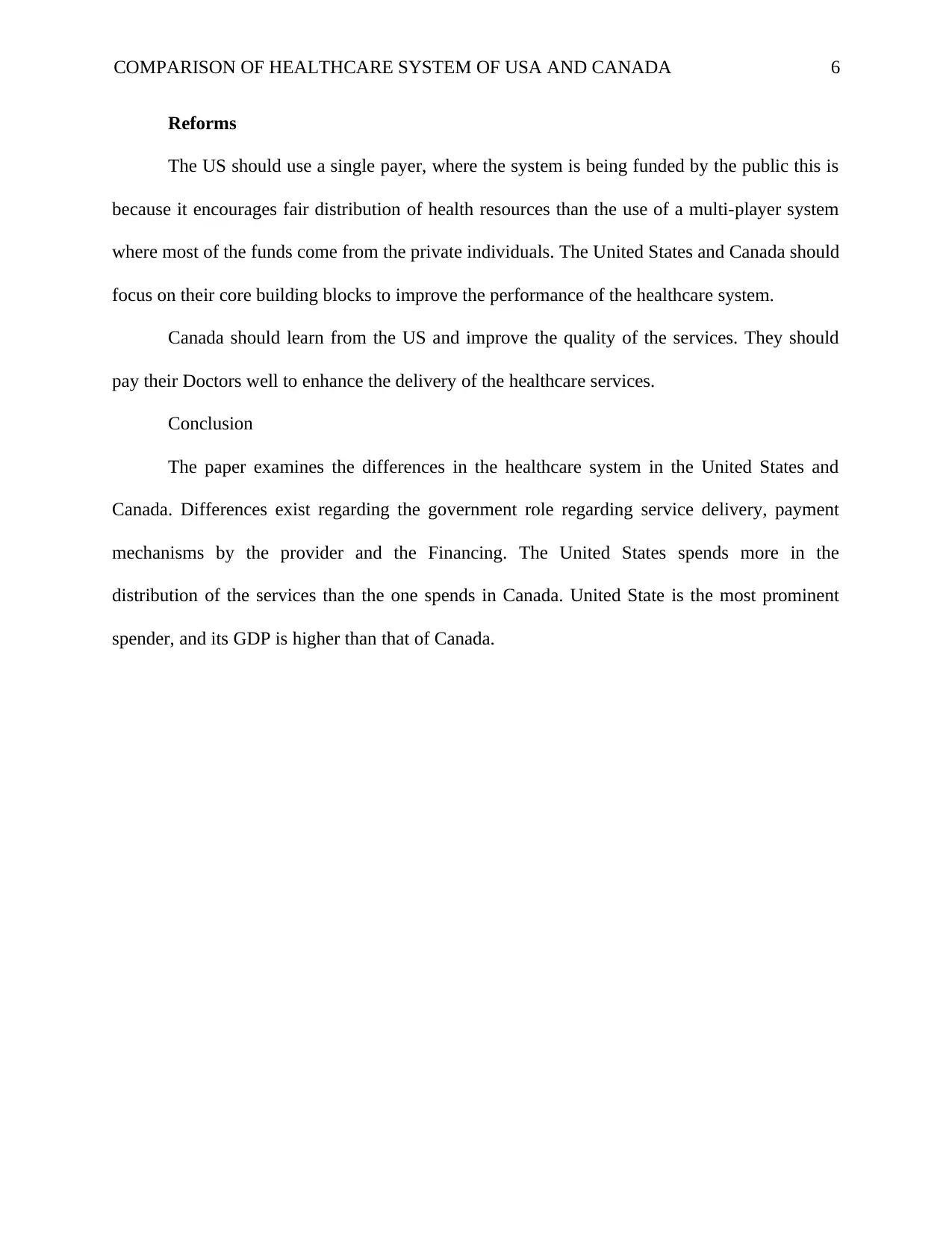
COMPARISON OF HEALTHCARE SYSTEM OF USA AND CANADA 6
Reforms
The US should use a single payer, where the system is being funded by the public this is
because it encourages fair distribution of health resources than the use of a multi-player system
where most of the funds come from the private individuals. The United States and Canada should
focus on their core building blocks to improve the performance of the healthcare system.
Canada should learn from the US and improve the quality of the services. They should
pay their Doctors well to enhance the delivery of the healthcare services.
Conclusion
The paper examines the differences in the healthcare system in the United States and
Canada. Differences exist regarding the government role regarding service delivery, payment
mechanisms by the provider and the Financing. The United States spends more in the
distribution of the services than the one spends in Canada. United State is the most prominent
spender, and its GDP is higher than that of Canada.
Reforms
The US should use a single payer, where the system is being funded by the public this is
because it encourages fair distribution of health resources than the use of a multi-player system
where most of the funds come from the private individuals. The United States and Canada should
focus on their core building blocks to improve the performance of the healthcare system.
Canada should learn from the US and improve the quality of the services. They should
pay their Doctors well to enhance the delivery of the healthcare services.
Conclusion
The paper examines the differences in the healthcare system in the United States and
Canada. Differences exist regarding the government role regarding service delivery, payment
mechanisms by the provider and the Financing. The United States spends more in the
distribution of the services than the one spends in Canada. United State is the most prominent
spender, and its GDP is higher than that of Canada.
⊘ This is a preview!⊘
Do you want full access?
Subscribe today to unlock all pages.

Trusted by 1+ million students worldwide
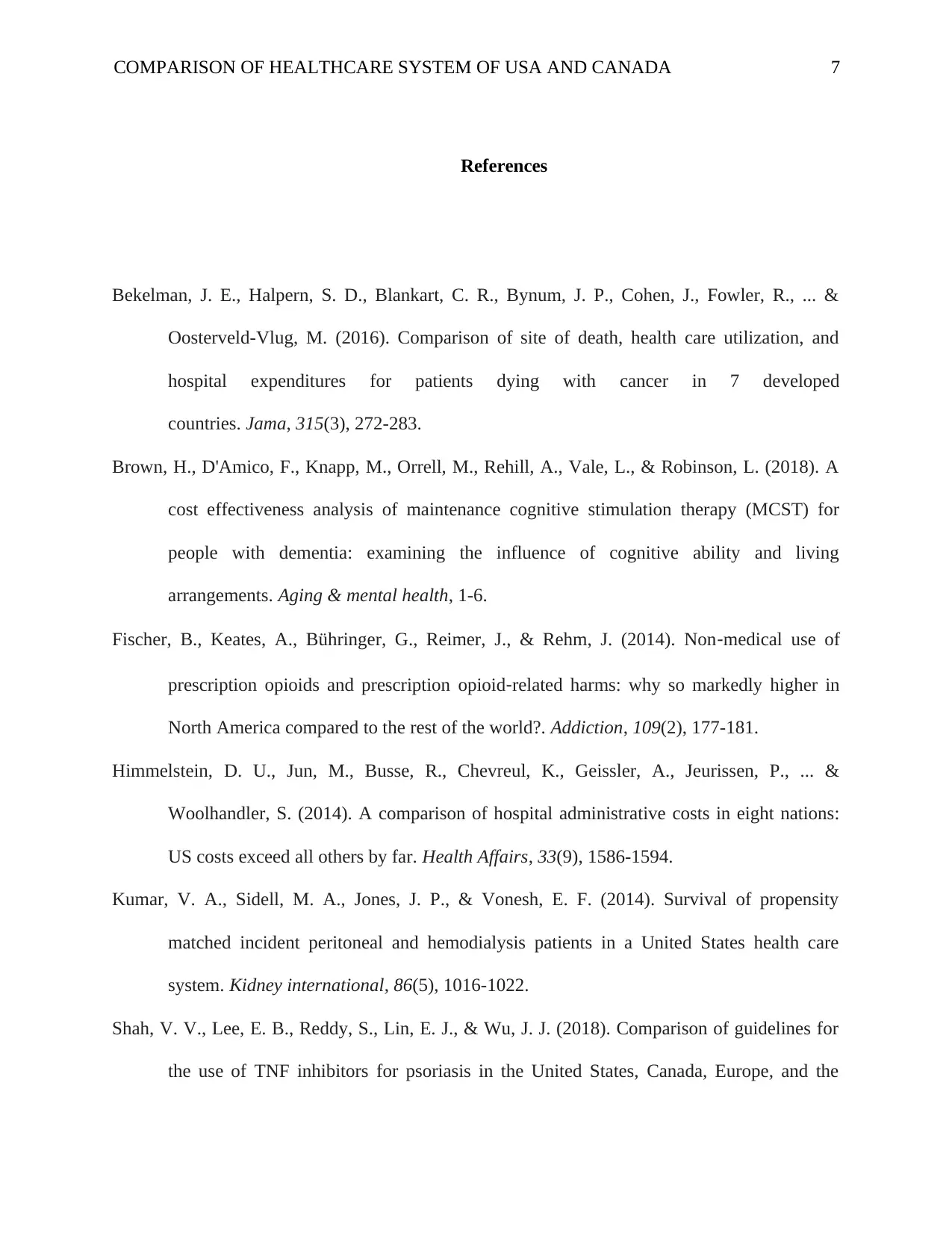
COMPARISON OF HEALTHCARE SYSTEM OF USA AND CANADA 7
References
Bekelman, J. E., Halpern, S. D., Blankart, C. R., Bynum, J. P., Cohen, J., Fowler, R., ... &
Oosterveld-Vlug, M. (2016). Comparison of site of death, health care utilization, and
hospital expenditures for patients dying with cancer in 7 developed
countries. Jama, 315(3), 272-283.
Brown, H., D'Amico, F., Knapp, M., Orrell, M., Rehill, A., Vale, L., & Robinson, L. (2018). A
cost effectiveness analysis of maintenance cognitive stimulation therapy (MCST) for
people with dementia: examining the influence of cognitive ability and living
arrangements. Aging & mental health, 1-6.
Fischer, B., Keates, A., Bühringer, G., Reimer, J., & Rehm, J. (2014). Non‐medical use of
prescription opioids and prescription opioid‐related harms: why so markedly higher in
North America compared to the rest of the world?. Addiction, 109(2), 177-181.
Himmelstein, D. U., Jun, M., Busse, R., Chevreul, K., Geissler, A., Jeurissen, P., ... &
Woolhandler, S. (2014). A comparison of hospital administrative costs in eight nations:
US costs exceed all others by far. Health Affairs, 33(9), 1586-1594.
Kumar, V. A., Sidell, M. A., Jones, J. P., & Vonesh, E. F. (2014). Survival of propensity
matched incident peritoneal and hemodialysis patients in a United States health care
system. Kidney international, 86(5), 1016-1022.
Shah, V. V., Lee, E. B., Reddy, S., Lin, E. J., & Wu, J. J. (2018). Comparison of guidelines for
the use of TNF inhibitors for psoriasis in the United States, Canada, Europe, and the
References
Bekelman, J. E., Halpern, S. D., Blankart, C. R., Bynum, J. P., Cohen, J., Fowler, R., ... &
Oosterveld-Vlug, M. (2016). Comparison of site of death, health care utilization, and
hospital expenditures for patients dying with cancer in 7 developed
countries. Jama, 315(3), 272-283.
Brown, H., D'Amico, F., Knapp, M., Orrell, M., Rehill, A., Vale, L., & Robinson, L. (2018). A
cost effectiveness analysis of maintenance cognitive stimulation therapy (MCST) for
people with dementia: examining the influence of cognitive ability and living
arrangements. Aging & mental health, 1-6.
Fischer, B., Keates, A., Bühringer, G., Reimer, J., & Rehm, J. (2014). Non‐medical use of
prescription opioids and prescription opioid‐related harms: why so markedly higher in
North America compared to the rest of the world?. Addiction, 109(2), 177-181.
Himmelstein, D. U., Jun, M., Busse, R., Chevreul, K., Geissler, A., Jeurissen, P., ... &
Woolhandler, S. (2014). A comparison of hospital administrative costs in eight nations:
US costs exceed all others by far. Health Affairs, 33(9), 1586-1594.
Kumar, V. A., Sidell, M. A., Jones, J. P., & Vonesh, E. F. (2014). Survival of propensity
matched incident peritoneal and hemodialysis patients in a United States health care
system. Kidney international, 86(5), 1016-1022.
Shah, V. V., Lee, E. B., Reddy, S., Lin, E. J., & Wu, J. J. (2018). Comparison of guidelines for
the use of TNF inhibitors for psoriasis in the United States, Canada, Europe, and the
Paraphrase This Document
Need a fresh take? Get an instant paraphrase of this document with our AI Paraphraser
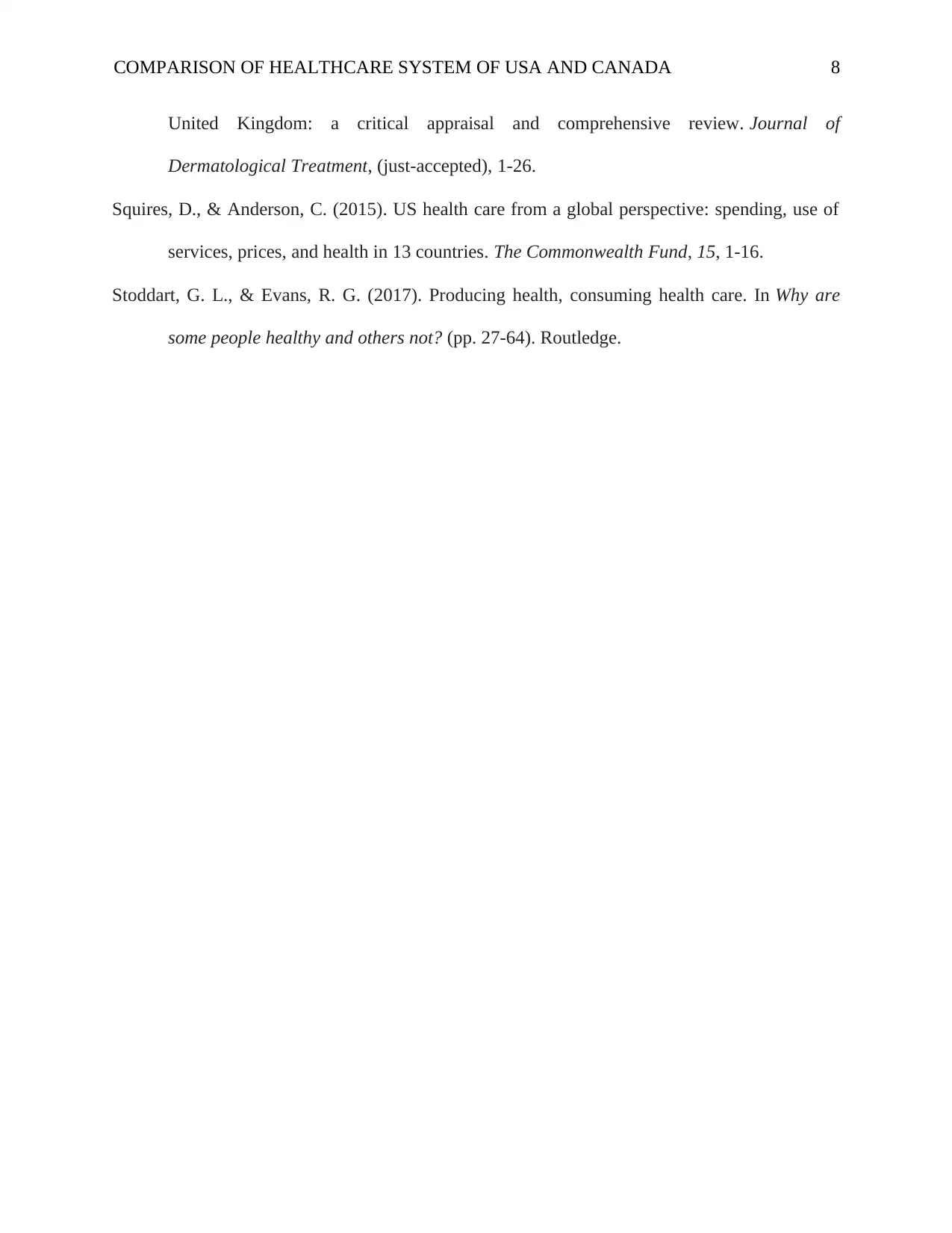
COMPARISON OF HEALTHCARE SYSTEM OF USA AND CANADA 8
United Kingdom: a critical appraisal and comprehensive review. Journal of
Dermatological Treatment, (just-accepted), 1-26.
Squires, D., & Anderson, C. (2015). US health care from a global perspective: spending, use of
services, prices, and health in 13 countries. The Commonwealth Fund, 15, 1-16.
Stoddart, G. L., & Evans, R. G. (2017). Producing health, consuming health care. In Why are
some people healthy and others not? (pp. 27-64). Routledge.
United Kingdom: a critical appraisal and comprehensive review. Journal of
Dermatological Treatment, (just-accepted), 1-26.
Squires, D., & Anderson, C. (2015). US health care from a global perspective: spending, use of
services, prices, and health in 13 countries. The Commonwealth Fund, 15, 1-16.
Stoddart, G. L., & Evans, R. G. (2017). Producing health, consuming health care. In Why are
some people healthy and others not? (pp. 27-64). Routledge.
1 out of 8
Related Documents
Your All-in-One AI-Powered Toolkit for Academic Success.
+13062052269
info@desklib.com
Available 24*7 on WhatsApp / Email
![[object Object]](/_next/static/media/star-bottom.7253800d.svg)
Unlock your academic potential
Copyright © 2020–2025 A2Z Services. All Rights Reserved. Developed and managed by ZUCOL.





